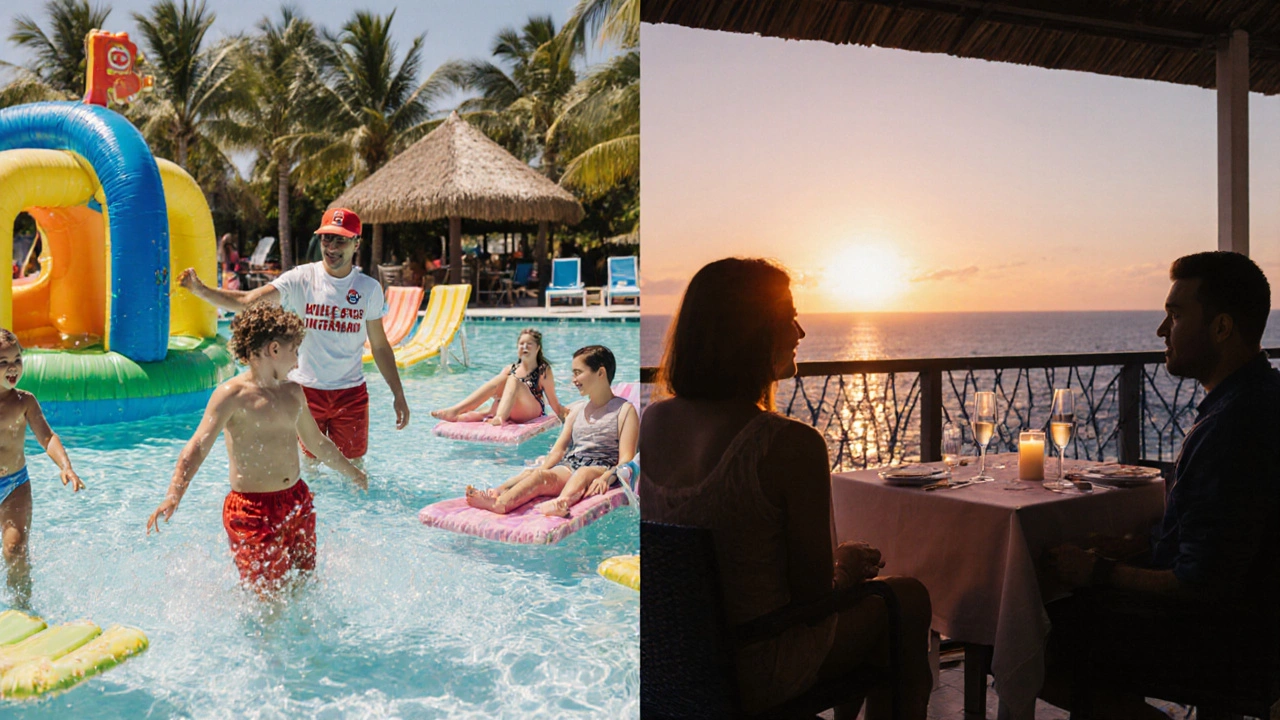All-Inclusive Hotel Score Calculator
Rate your top priorities and evaluate hotels against your needs. Calculate your ideal hotel score based on the key factors that matter most to you.
Your Priority Settings
Assign weights to each category based on what matters most to you. Total weight should equal 30 (as shown in the article).
Evaluate a Hotel
Enter your ratings for each category (1-5 stars) for the hotel you're considering.
Results
Your Hotel Score
0
Score Breakdown
What does this score mean?
30 = Perfect match for your priorities
24-29 = Excellent match
18-23 = Good match
12-17 = Average
Below 12 = Consider other options
When you start scrolling through endless options, the biggest question is: what really makes an best all-inclusive hotel stand out? It’s not just about a cheap price tag or a fancy pool; it’s a mix of location, food quality, activities, and the little comforts that turn a standard stay into a memorable vacation. Below is a hands‑on guide that helps you weigh each factor, avoid common pitfalls, and land on the resort that fits your style and budget.
What "Best" Really Means for an All‑Inclusive Hotel
First, define what "best" looks like for you. Some travelers chase gourmet meals, others need kid‑friendly clubs, and a few just want a beachfront with zero‑stress service. The term is subjective, but the underlying criteria are universal: location, inclusions, service quality, and value for money.
Step 1: Set Your Travel Priorities
Before you compare any resort, write down the top three things you can’t compromise on. Typical priorities include:
- Proximity to the beach or a particular attraction
- Variety and quality of dining options
- Range of on‑site activities (water sports, spa, kids’ club)
- Room type and privacy level
- Overall vibe - party‑centric vs. tranquil
Having a clear checklist narrows down the pool of hotels and speeds up the decision.
Step 2: Evaluate Location and Beach Access
A great all‑inclusive resort starts with a great setting. Look for:
- Direct beach access (no shuttle needed)
- Water clarity and safety - reputable resorts often publish recent water‑quality reports
- Nearby attractions - whether you want to explore local culture or stay on‑site
Tools like Google Earth or recent traveler photos can confirm how the beach actually looks, because promotional images are sometimes outdated.
Step 3: Scrutinize the Food and Beverage Options
All‑inclusive packages can vary wildly in culinary scope. Ask yourself:
- How many restaurants are on the property? Buffets only, or a la carte venues?
- Do they cater to dietary restrictions - gluten‑free, vegan, halal?
- Is there a focus on local cuisine or just generic international fare?
Read recent reviews on sites like TripAdvisor; a pattern of “repetitive food” or “slow service” signals a red flag.
Step 4: Look at Entertainment and Activities
From beach volleyball to nightly shows, the activity roster tells you how much you’ll actually do without leaving the resort. Consider:
- Water sports inclusion - snorkeling, kayaking, paddleboarding
- Kids’ programs - supervised clubs, teen zones, family‑oriented excursions
- Evening entertainment - live music, themed parties, cultural performances
Some resorts charge extra for premium activities; always verify what’s truly "all‑included."
Step 5: Assess Room Comfort and Amenities
After a day of sun, you’ll spend most of your time in the room. Key things to check:
- Room size - are you booking a standard twin, a suite, or a villa?
- Private balcony or sea view - adds perceived value
- In‑room amenities - minibar, coffee maker, high‑speed Wi‑Fi
Many resorts now publish detailed floor plans and photos; use them to avoid surprises.

Step 6: Review Family‑Friendly vs. Couple‑Friendly Features
If you travel with kids, a dedicated kids’ pool, baby‑care services, and child‑proof rooms are non‑negotiable. Couples, on the other hand, may prioritize romantic dinner settings, adults‑only pools, and spa suites. Make sure the resort’s marketing aligns with your party composition.
Step 7: Compare Pricing and Value
All‑inclusive pricing can be opaque. Break down the total cost into components:
- Base room rate
- Taxes and resort fees (often 10‑15% of the bill)
- Optional upgrades (premium liquor, exclusive tours)
Use a simple spreadsheet to see which resort gives the most amenities per dollar. Remember, the lowest price isn’t always the best value if you end up paying extra for meals or activities.
Step 8: Verify Sustainability and Safety Standards
Eco‑conscious travelers should check for certifications such as Green Globe or EarthCheck. Safety matters too - look for on‑site medical centers, lifeguard presence, and recent health‑inspection scores.
Quick Comparison Table
| Criterion | Weight (1‑5) | Typical Rating Range |
|---|---|---|
| Beachfront location | 5 | 3‑5 |
| Food & beverage quality | 5 | 2‑5 |
| Activities & entertainment | 4 | 3‑5 |
| Room comfort | 4 | 3‑5 |
| Family or couple friendliness | 3 | 2‑5 |
| Price/value ratio | 5 | 3‑5 |
| Sustainability & safety | 3 | 2‑5 |
Step‑by‑Step Checklist Before Booking
- Define your top three priorities.
- Shortlist resorts that match your desired destination and budget.
- Read the latest guest reviews - focus on food, service, and hidden fees.
- Confirm what is truly "all‑included" on the hotel’s website.
- Check the resort’s sustainability certifications and safety records.
- Use the table above to score each resort against your priorities.
- Calculate total cost including taxes and optional upgrades.
- Book directly through the hotel’s official site to avoid third‑party surcharges.
Following this process typically narrows down the options to one or two clear winners, saving you hours of indecision.
Common Mistakes to Avoid
- Assuming all‑inclusive means all‑you‑can‑eat. Some drinks, premium restaurants, or specialty excursions are extra.
- Ignoring the fine print on resort fees - they can add 15% to the total.
- Choosing based solely on flashy marketing images; verify with recent traveler photos.
- Overlooking the weather patterns of the destination - a rainy season can ruin a beach stay.
- Booking far in advance without checking cancellation policies; flexible rates are worth a small premium.

Final Thoughts
Finding the best all-inclusive hotel is less about luck and more about a systematic approach. By clarifying your priorities, digging into genuine guest feedback, and using a simple scoring system, you’ll end up at a resort that feels tailored to your vacation style, not a one‑size‑fits‑all package.
What does "all‑inclusive" actually cover?
A true all‑inclusive deal includes accommodation, all meals (breakfast, lunch, dinner, snacks), drinks (including alcohol in many cases), and most on‑site activities. Always read the fine print for exclusions like premium dining, spa treatments, or excursions.
How can I tell if a resort’s food quality is good?
Check recent guest reviews for mentions of variety, freshness, and service speed. Look for awards (e.g., Michelin Plate, local culinary recognitions) and verify if the resort offers multiple themed restaurants rather than a single buffet.
Are all‑inclusive resorts safe for families with young children?
Most family‑focused resorts provide kids’ clubs, child‑proof rooms, shallow pools, and on‑site medical staff. Look for certifications like “Family Friendly” badges and read reviews from other parents about staff responsiveness and safety measures.
Should I book through the hotel or a third‑party site?
Booking directly often gives you the best room selection, flexible cancellation, and occasional upgrade perks. Third‑party sites can offer lower base rates but may add hidden fees and stricter policies.
What sustainability signs should I look for?
Look for certifications such as Green Globe, EarthCheck, or local eco‑label programs. These indicate the resort follows practices like water recycling, energy efficiency, and responsible waste disposal.
